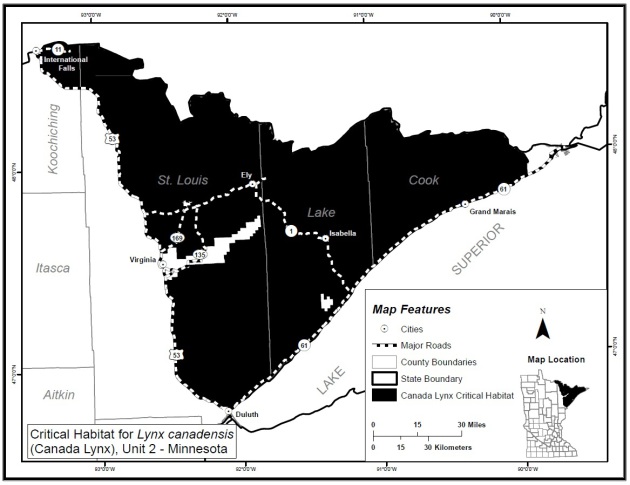The full Blog post2, with any associated images and links can be viewed here. |
Feds set 'critical
habitat' limits for
threatened lynx
Posted by: James Eli Shiffer Updated: October 14, 2014 - 10:35 AM
Should you come across the elusive Canada lynx in the
Arrowhead, be aware that they're in one of five parts of
the United States designated as "critical habitat" for a
wild cat in danger of extinction. On Tuesday, the U.S.
Fish & Wildlife Service's final rule designating
prime lynx territory went into effect. The lynx thrives in
large tracts of boreal forest, where it can find its favorite
meal, snowshoe hares, and "persistent deep, fluffy snow,
" which the tufted-ear cats can navigate better than
bobcat and other hare predators, according to the agency.
Arrowhead, be aware that they're in one of five parts of
the United States designated as "critical habitat" for a
wild cat in danger of extinction. On Tuesday, the U.S.
Fish & Wildlife Service's final rule designating
prime lynx territory went into effect. The lynx thrives in
large tracts of boreal forest, where it can find its favorite
meal, snowshoe hares, and "persistent deep, fluffy snow,
" which the tufted-ear cats can navigate better than
bobcat and other hare predators, according to the agency.
The designation of critical lynx habitat in Minnesota,
Maine, Montana, Idaho, Wyoming and Washington
followed a lawsuit by environmental advocates to boos
t the protection of lynx, which have been listed as
"threatened" since 2000. The designation could affect
timber harvesting and other activities on public lands,
which make up about 85 percent of the 8,069-square
-mile critical habitat in Minnesota, but it won't interfere
with development on private land unless it requires
a federal wetlands permit.
Maine, Montana, Idaho, Wyoming and Washington
followed a lawsuit by environmental advocates to boos
t the protection of lynx, which have been listed as
"threatened" since 2000. The designation could affect
timber harvesting and other activities on public lands,
which make up about 85 percent of the 8,069-square
-mile critical habitat in Minnesota, but it won't interfere
with development on private land unless it requires
a federal wetlands permit.
So how many lynx remain in the United States? No
one really knows. Wild cats are notoriously hard to
spot,
and most evidence points to a very small population
of
lynx. The Fish & Wildlife fact sheetdoesn't even
venture a guess. Nor do a number of wildlife advocacy
groups. Only 63 confirmed sightings of lynx were
documented in Minnesota from 2000 to 2006,
according to the Department of Natural Resources.
one really knows. Wild cats are notoriously hard to
spot,
and most evidence points to a very small population
of
lynx. The Fish & Wildlife fact sheetdoesn't even
venture a guess. Nor do a number of wildlife advocacy
groups. Only 63 confirmed sightings of lynx were
documented in Minnesota from 2000 to 2006,
according to the Department of Natural Resources.










No comments:
Post a Comment